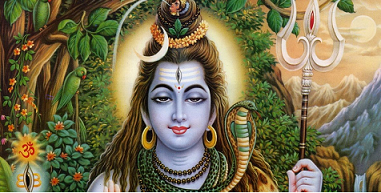After Sita Mata was kidnapped by Raavan, a despondent Shree Raam was advised by Sage Agastya to perform the pashupatta vrat, a special sacrifice to please Lord Shiva. Shree Raam then recited the Shiva Sahasranaam, 1,000 names of Lord Shiva. Pleased with His sacrifice, Bhagavan Shankar appeared and granted him a special weapon, the maha pashupatastra, that He could use to destroy Raavan. Shree Raam then enquired about the origin of creation. Bhagavan Shankar then blessed Shree Raam with a Divine experience, the overwhelming vision of seeing all creation. Shree Raam praised Shivaji, who invited Shree Raam to ask him any questions.
This episode from the Ramayan is part of the Shiv Geeta, a dialogue between Shree Raam and Bhagavan Shiva. The scripture is vast, covering various topics. It is found in the latter part (Uttara khand) of the Padma Puraana. Chapter 12 deals with Upaasanaa Gyaan: how to worship Lord Shiva. We all have some suffering in life, which drives us toward learning about the reality of existence. We then develop the attitude of a seeker. The methods by which we can get the answers to our questions are the scientific method and the spiritual method. The scientific method is measurable; maya is the root of the word, ‘to measure’, which also means ‘the illusion of individuality’. Such measurement is based on the observable world. The spiritual method goes beyond the material world, beyond the mind and senses and beyond maya.
In this dialogue, Shree Raam asked, “O Parameshwar, please tell me the method for worshipping you.” Shivaji said, “O Raam, listen carefully to the methods and rules of upaasanaa. The bodies of all deities, all principles of nature, have been created from Me only. Therefore, whoever does upaasanaa, to whichever deity you choose, all such devotees attain Me only.”
Lord Shiva is saying that all the Deities to whom humans pray are just manifestations of the One Supreme. Even you and I are manifestations of that Supreme Being, Brahman. He is the Source of everything, beyond the mind and senses. He is the fundamental cause. The root of the word, Brahman, means ‘to swell, expand or grow’. Everything that you see around you is Brahman in a differentiated state. Brahman is the seed from which everything springs forth. The ocean of infinite consciousness is Brahman. The waves on the ocean are all the forms of creation, yet the waves are still part of the ocean, just as we are all connected to one source. Everything is made up of the One principle, the cosmic energy. However, we do not recognise this truth in our daily lives and that is the root of our ignorance. The end goal is not just to understand this intellectually, but also to experience and attain that state of Oneness.
Bhagavan Shankar continued, “As prescribed in the scriptures, people worship without realising that I am the enjoyer of everything. Whoever worships like this, he gets limited fruition.” In other words, if we worship without the understanding that we are worshipping this one Supreme Reality in these different forms, we will get limited spiritual results.
“This creation that you see is not different from Me and I am the target of all kriyas (activities). I am the giver of fruits.” All forms of worship exist in Him. He is the cause.
“Whichever form of God one worships, in that form itself, I appear and fulfil their wishes. One who keeps firm devotion in Me and sees no difference between him and Me, in essence, such a devotee would remain unstained, even if he performs the sin of Bramhatiya (the sin of killing a Brahmin, a holy man).” Shivaji is saying, have firm devotion in Me and see Me in everyone and everything. It means seeing that underlying reality everywhere, in everyone and everything. This only happens through practice.
Bhagavan Shankar described several categories of worship in this chapter. There are two kinds of upaasanaa that we should be aware of: sampad upaasanaa and adhyaas upaasanaa. This addresses the idea of worshipping symbols such as murtis. As Shree Krishna said in the Gita, “Concentrating on the formless is difficult for body-conscious people.” It is difficult to concentrate on the void or formlessness. In the beginning of worship, we must use forms and symbols to connect with the spiritual essence. In sampad upaasanaa, the qualities of a higher concept are superimposed on a lower form, but the attention is on the higher concept.” The Shiva lingam, for example, is represented by a circular stone, but when we worship it, we contemplate that vast infinity, the void and the spaciousness of Lord Shiva. The sun, which is very distant from the earth, still radiates everywhere. The Supreme Spirit lights up all creation but remains untouched and pure. The sun, Suruj Devta, the lower concept, represents the higher concept, Brahm.
In adhyaas upaasanaa, the symbol itself predominates, and on it are superimposed the qualities of the infinite. All the qualities of the Divine are brought to bear on a particular object, such as a murti, and it is worshipped as if it is the Supreme. This is how puja is performed: we create a bedi that represents the universe; we invite the Devtas to sit and so forth. We are superimposing infinite qualities of the Divine into a limited material space.
Shivaji also says, “Upaasanaa is really meditating by focusing within oneself.” This means that there is nothing external about worship. “Whenever one’s mind, focus and heart gets firmly established in upaasanaa, one can sit and perform upaasanaa there itself. Otherwise, visiting sacred places for upaasanaa is useless.” This means that we could go to sacred places but it does not necessarily mean that we are performing upaasanaa. Wherever you are, once you turn within, you can perform upaasanaa.
From a Sunday morning service with Pt. Dr. Umesh Persad, Spiritual Leader, Gyaan Deepak Kirtan Mandali.



